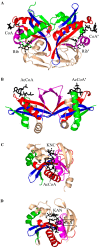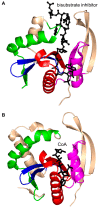Structure and Functional Diversity of GCN5-Related N-Acetyltransferases (GNAT)
- PMID: 27367672
- PMCID: PMC4964394
- DOI: 10.3390/ijms17071018
Structure and Functional Diversity of GCN5-Related N-Acetyltransferases (GNAT)
Abstract
General control non-repressible 5 (GCN5)-related N-acetyltransferases (GNAT) catalyze the transfer of an acyl moiety from acyl coenzyme A (acyl-CoA) to a diverse group of substrates and are widely distributed in all domains of life. This review of the currently available data acquired on GNAT enzymes by a combination of structural, mutagenesis and kinetic methods summarizes the key similarities and differences between several distinctly different families within the GNAT superfamily, with an emphasis on the mechanistic insights obtained from the analysis of the complexes with substrates or inhibitors. It discusses the structural basis for the common acetyltransferase mechanism, outlines the factors important for the substrate recognition, and describes the mechanism of action of inhibitors of these enzymes. It is anticipated that understanding of the structural basis behind the reaction and substrate specificity of the enzymes from this superfamily can be exploited in the development of novel therapeutics to treat human diseases and combat emerging multidrug-resistant microbial infections.
Keywords: GNAT; acetyltransferase; catalytic residues; crystal structure; enzyme inhibitor; reaction mechanism.
Figures
























Similar articles
-
Crystal structure of the histone acetyltransferase Hpa2: A tetrameric member of the Gcn5-related N-acetyltransferase superfamily.J Mol Biol. 1999 Dec 17;294(5):1311-25. doi: 10.1006/jmbi.1999.3338. J Mol Biol. 1999. PMID: 10600387
-
Crystal structure of Helicobacter pylori pseudaminic acid biosynthesis N-acetyltransferase PseH: implications for substrate specificity and catalysis.PLoS One. 2015 Mar 17;10(3):e0115634. doi: 10.1371/journal.pone.0115634. eCollection 2015. PLoS One. 2015. PMID: 25781966 Free PMC article.
-
Repurposing the GNAT Fold in the Initiation of Polyketide Biosynthesis.Structure. 2020 Jan 7;28(1):63-74.e4. doi: 10.1016/j.str.2019.11.004. Epub 2019 Nov 27. Structure. 2020. PMID: 31785925 Free PMC article.
-
Bacterial GCN5-Related N-Acetyltransferases: From Resistance to Regulation.Biochemistry. 2016 Feb 23;55(7):989-1002. doi: 10.1021/acs.biochem.5b01269. Epub 2016 Feb 9. Biochemistry. 2016. PMID: 26818562 Free PMC article. Review.
-
Catalysis by protein acetyltransferase Gcn5.Biochim Biophys Acta Gene Regul Mech. 2021 Feb;1864(2):194627. doi: 10.1016/j.bbagrm.2020.194627. Epub 2020 Aug 22. Biochim Biophys Acta Gene Regul Mech. 2021. PMID: 32841743 Free PMC article. Review.
Cited by
-
Loss of Chloroplast GNAT Acetyltransferases Results in Distinct Metabolic Phenotypes in Arabidopsis.Plant Cell Physiol. 2023 May 15;64(5):549-563. doi: 10.1093/pcp/pcad017. Plant Cell Physiol. 2023. PMID: 37026998 Free PMC article.
-
A Mononuclear Iron-Dependent Methyltransferase Catalyzes Initial Steps in Assembly of the Apratoxin A Polyketide Starter Unit.ACS Chem Biol. 2017 Dec 15;12(12):3039-3048. doi: 10.1021/acschembio.7b00746. Epub 2017 Nov 14. ACS Chem Biol. 2017. PMID: 29096064 Free PMC article.
-
Ribosomally derived lipopeptides containing distinct fatty acyl moieties.Proc Natl Acad Sci U S A. 2022 Jan 18;119(3):e2113120119. doi: 10.1073/pnas.2113120119. Proc Natl Acad Sci U S A. 2022. PMID: 35027450 Free PMC article.
-
Substrate specificities of Escherichia coli ItaT that acetylates aminoacyl-tRNAs.Nucleic Acids Res. 2020 Jul 27;48(13):7532-7544. doi: 10.1093/nar/gkaa487. Nucleic Acids Res. 2020. PMID: 32501503 Free PMC article.
-
Cohesive Properties of the Caulobacter crescentus Holdfast Adhesin Are Regulated by a Novel c-di-GMP Effector Protein.mBio. 2017 Mar 21;8(2):e00294-17. doi: 10.1128/mBio.00294-17. mBio. 2017. PMID: 28325767 Free PMC article.
References
Publication types
MeSH terms
Substances
LinkOut - more resources
Full Text Sources
Other Literature Sources

